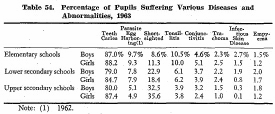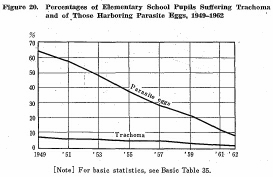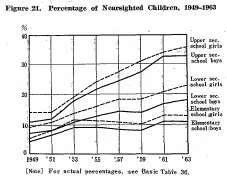| Home > Policy > White Paper, Notice, Announcement > White Paper > EDUCATIONAL STANDARDS IN JAPAN 1965 > CHAPTER |
||
Diseases of highest incidence among pupils are teeth caries, nearsightedness, enlarged tonsils, conjunctivitis, trachoma, skin disease, ozone and parasite egg harboring.
Improvement of environmental hygiene, careful management of school health, medical and dental examinations and service has been conductive


to the prevention and control of these diseases. Especially the numbers of pupils suffering from trachoma and pediculosis are decreasing.
However, attention must be drawn to the fact that the number of pupils who are nearsighted or have decayed teeth tend to increase year by year.
In 1963 the percentage of near-sightedness for boys was 10.5 in elementary schools, 18.4% in lower secondary schools, 32.5% in upper secondary schools; whereas that for girls was 13.1%, 22.9%, and 35.6%; respectively for these school levels. In all levels of schools, the percentage are higher for gir1s than foe boys, and the more advanced the grade is, the higher the percentage for both sexes tends to be.

Teeth caries have the highest incidence of all diseases among all levels of school: in 1963 81.1 percent in elementary schools, 75.5 percent in lower secondary schools, 76.0 percent in upper secondary schools, that is to say, nearly 80 percent of al1 pupils had decayed teeth. The number of pupils who have had some dental treatment is gradually increasing, but there are still many pupils who have not received any dental treatment. In the United Kingdom too, the incidence of near-sightedness and decayed teeth is relatively high is e1ementary and secondary schools in 1961, 26.2% were near-sighted and 63.4% had decayed teeth.
| Back to Top | MEXT HOME |